Is the water bottle man’s new best friend? Whether tap water, coffee, tea, or fizzy drinks – the drinking bottle is on everyone’s lips and more popular than ever. Of course, the market has long since reacted and brings the new daily companion in all shapes and colors.
We have reviewed water bottles made of aluminum, glass, plastic, and stainless steel. The focus was primarily on leak tightness because the water bottle should not only be tightly closed on the office table but also during exercise or filled with soda.
What is a water bottle, anyway?
A water bottle should primarily serve one purpose: it should be leakproof. To do this, it should be able to keep the temperature halfway: cold drinks should stay cold and warm drinks should stay warm. You can actually go wrong with a purchase if you don’t worry about what you will need beforehand.
In addition, water bottles are more complex these days and can simply do more than they used to be. Of course, the cyclist doesn’t need hot coffee in his water bottle, and in the office, you don’t necessarily need the unbreakable outdoor water bottle model.
For you, however, it could sometimes be crucial that the opening is large enough and ice cubes can fit in, or that the closure can be opened easily and with one hand. In total, we tested 20 bottles and were able to find out which materials are best for which use. In addition to stainless steel and plastic, we also examined water bottles made of aluminum and glass.
In addition, we present our tips for choosing the best glass water bottle and the best water bottle for carbonated beverages. We explain to you how much money you actually have to spend on a water bottle and how expensive which material can be. In addition to detailed purchase advice, you will also find answers to frequently asked questions in connection with water bottles.
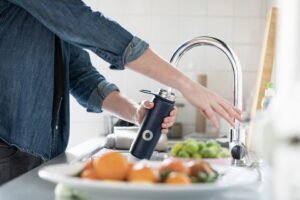
How much money should you spend on a good water bottle?
A refillable drinking bottle quickly pays for itself if you switch to tap water instead of expensive mineral water from the supermarket at the same time. However, there are price differences depending on which material you choose. Read more about this below. So before you get yourself a bottle, you should think about what situations you need a bottle for. The volume, i.e. the filling quantity, plays a role just as much as the insulation capacity. Handiness is also a decisive factor, which is reflected in the price.
If you are looking for a simple drinking bottle for everyday use, from which you mainly take cold drinks such as cold tap water, then you do not have to spend more than $15. Simple plastic bottles do the trick, the material is basically the cheapest.
Alternatively, you can also choose aluminum bottles. Glass bottles are a bit more stylish and therefore also more expensive. They also insulate only a little but are ideally suited for everyday use. Here it usually starts from 15 euros.
If you are looking for a drinking bottle for sports, then you are priced like simple everyday bottles at less than $15. The closure is of course a decisive criterion here – it should not only be tight but also easy to handle. Break resistance and weight are also essential. All of these requirements are usually combined in one plastic bottle.
For hot drinks, we recommend bottles made of stainless steel, ideally double-walled models. The focus is on insulating properties, which is why they are usually a bit more expensive. You will find what you are looking for at prices from $30.
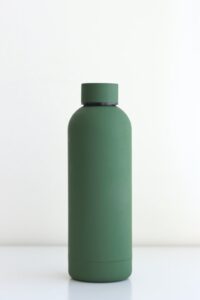
The best materials for water bottles
Stainless steel bottles are sturdy, long-lasting and are best at keeping temperatures. In addition, they are almost always dishwasher-safe – but the powder coating usually suffers as a result. However, these models are never made entirely of stainless steel, so lids or closures are often made of plastic, ideally BPA-free. A disadvantage that many do not think of at first: stainless steel bottles are not transparent. The same goes for aluminum bottles. These are usually a little lighter, at best cheaper, but not overly sustainable in terms of raw material extraction and production.
These days, almost all plastic bottles are BPA-free, so no potentially harmful substances are used. Most of them are made of Tritan, a heat-resistant polyester. This is why these bottles are not only robust and transparent, but also heat-resistant up to around 100°C. They are therefore also dishwasher-safe, but their longevity suffers from the high temperatures and the material suffers from chemicals such as rinse aid.
Glass is also durable and recyclable, and the bottles can also be cleaned in the dishwasher. Only the print could suffer. The biggest drawback, however, is the weight, because glass bottles are the heaviest in comparison. They also break quickly. However, the material is also stylish and some people find it more pleasant to drink from a glass bottle – it’s difficult to justify this on the basis of data, but we can understand it. You just have to get used to the fact that your drink will quickly reach room temperature.
Toxic plastics: What role do BPA and similar chemicals play?
You don’t really have to worry about harmful substances with modern drinking bottles, as almost all of them are now BPA-free. Bisphenol A, better known under the abbreviation BPA, is a chemical that hardens plastics and makes them durable. The substance with hormone-like effects occurs more frequently in disposable bottles or food packaging, but also in toys.
Health is at risk precisely when materials with BPA are heated, because then the chemical dissolves and mixes with the contents of the bottle. Therefore, it is better to throw away drinks from single-use bottles that have heated up in the car. As usual with pollutants, however, the following applies: The amount makes the poison. So if you drink from a plastic bottle every now and then, you don’t have to be guided by a fear of BPA.
The law only bans the use of BPA in drinking bottles for babies, but you will hardly find any reusable containers with BPA. Here you are on the safe side with plastic containers with a corresponding note. All bottles we tested are BPA free.
The way aluminum is used in drinking bottles is not harmful to health. But the production and extraction of the raw material are energy inefficient and therefore not sustainable or good for the environment. So you should plan to use an aluminum bottle for a long time.
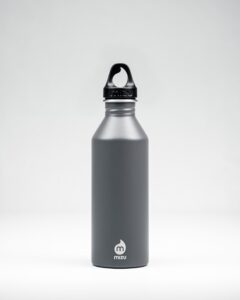
Folding water bottles: advantages and disadvantages
The folding water bottle is a particularly space-saving variant of the drinking container. They have their own rules. There is no folding bottle in our test because the disadvantages are unfortunately too present and the area of application too specific.
This version of the water bottle can shine when traveling. Especially at the security check at the airport, you can easily carry the folding version in your hand luggage and then fill it up. The special bottles are usually built up like an accordion and, as the name suggests, can be folded up small. However, this luxury comes with some compromises.
Often not too much fits in, rarely more than half a liter. Since the material, usually silicone, has to be particularly flexible, the mouthpiece or the drinking opening can also bend and impair the tightness. Drinking is often an ordeal, because the bottle just moves, especially when there is not much left in it. Finally, due to the material, folding bottles occasionally have an aftertaste.
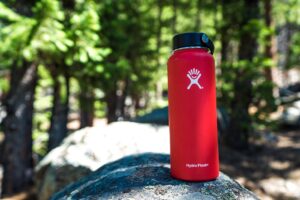
Water bottles: Purchase advice
Buying a water bottle is not a science in itself, even if the flood of information about special areas of application and material characteristics suggests that. If you are not sure which bottle is the right one for you, then we have summarized the key points here again.
Tightness
The supreme discipline of the water bottle, which must always be fulfilled regardless of the material or area of application. In addition to carbonated drinks, pitfalls are often improper closing. This happens especially with more complicated closures such as sports water bottles. The lateral position is also occasionally problematic. Leak-tightness must be guaranteed, especially in backpacks and bags, in which all kinds of electronics such as tablets or headphones can be found today.
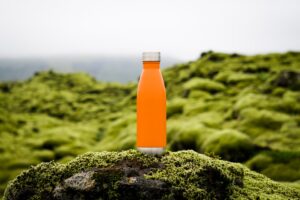
Insulation
Experience has shown that there are only very few differences in performance when it comes to vacuum flasks. So it is best to make sure that sealing elements can be easily exchanged, replaced, and cleaned.
Opening mechanisms: advantages and disadvantages
Here the classic screw cap with its own lid stands against the practical sports cap with one-hand operation. Here you have to weigh up what is more important to you: The screw-on lid is usually tighter and these bottles are more suitable for bubbly, but always have to be operated with two hands and lids can get lost if not attached to the bottle.
Caps to snap open and water bottles with drinking straws are more practical but often less tight. Carbonated content makes these closures only too happy to pop open and cleaning is also more complicated here.
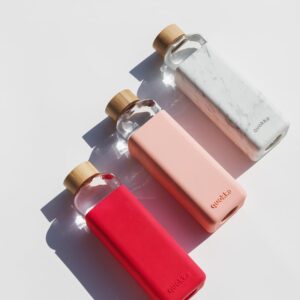
Capacity versus size
Double-walled water bottles are practical because the contents keep their temperature longer. But here less fits in for the size. In general, large bottles are not always practical and you should weigh carefully how much liquid you want to have with you. Pay close attention to where you want to use your companion, think of cup holders on the bike or in the car.
Handling
The material and size determine how well a water bottle fits in the hand. Again, it is advisable to discuss the area of application before buying. If you need a particularly large bottle at work and then drink from glasses on site, the bottle can also be operated with two hands. The focus here should be on functionality. Additional covers or carrying hooks are particularly practical.
Drinking opening
The larger the opening, the more likely you are to drink from your water bottle as if you were drinking from a glass. Filling it with ice cubes is then no problem. On the move or in motion, however, it can sometimes go wrong, small openings are better here. Drinking straws are of course very useful when exercising, but if you want to pour your drink out and drink it from another container, such as a cup, this is often cumbersome. There is no such thing as the perfect opening, the ideal size is a matter of taste.
Cleaning
Manual cleaning can be a pain; you usually need additional equipment such as bottle brushes. You can read about how to properly clean thermos flasks in another post. If the bottle can simply be put in the dishwasher, life will be a lot easier. Pay attention to the manufacturer’s instructions, but get used to the fact that prints wash off after a long time.
Conclusion
Finally, the new water bottle is here – now you can start! But before you drink from the bottle, you should first clean it. It’s very easy: clean all parts in warm water with a little washing-up liquid with a brush, rinse with clear, lukewarm water, allow to dry or dry. To dry, place the drinking bottle at a slight angle and upside down so that air can get into the inside of the bottle.
And this is exactly what regular basic cleaning looks like. Because every water bottle should be cleaned regularly. It’s not just about removing the remains of the last drink, but also about preventing mold from forming.

FAQ
Which water bottle is perfect for on the go?
For on the go and for athletes, we recommend the Ion8 water bottle, as it is not too small at 500 milliliters and is still very handy. Thanks to the anti-gluck opening, you can both drink and pour from the straw and the closure can be operated with one hand.
Which water bottles do not leak?
None of the bottles we tested are leaking. However, it gets exciting with bubbly. If you fill the vessels with carbonated beverages, some of them will be leak-proof. Bottles with screw-on lids are always tighter than snap closures; the aluminum bottle from Sigg is particularly tight and therefore recommended for use with soda.
Which water bottle is suitable in school?
If you carry your water bottle or that of your child in a backpack, then it should be particularly tight. In addition, it has to be light but must not be too small at the same time. Glass bottles are ruled out as well as sports bottles: While the former are too heavy, the latter usually fail because of their tightness.
The all-rounder, the stainless steel “milkybottle” from 720 ° DGREE, is recommended because it can also be used to bring tea with you. The aluminum bottle from Sigg is also good for everyday school life because it is particularly tight and light at the same time.

